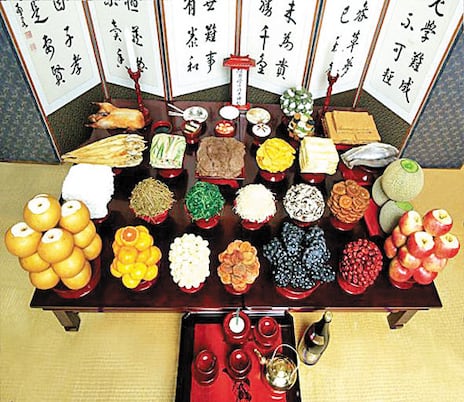Many a housewife is confused about how to set up the ritual table for Chuseok or Korean Thanksgiving, and annual practice is of small help when the challenge arises anew.
One familiar seasonal sight is of families squabbling over the exact positioning of fruit and meat while setting out the ritual table in the morning. To make matters worse, there is no single way to do it right, as it varies from region to region, family to family. But some iron principles apply, and here they are:

◆ Direct the ritual table to the north.
◆ Put better food closer to the soul of the dead.
Put rice and soup first. Then, arrange food in the order of quality and price from the perspective of the past. Put more expensive and better food closer to the souls of the ancestors -- that is, the back of the table. So, a ritual table should be set with fruit, the least expensive and valued food, in the front row; seasoned vegetables and fried dishes (jeon) in the next row; and boiled food in the last row. However, in some regions, the positions of fried and boiled dishes are interchanged. When there are too many dishes crammed in a row, you may move some to another row.
◆ Put better food to the right of the soul of the dead.
There are two reasons for putting better food on the right. One is that most people are right-handed and the other is that when we worship our ancestors, we place more senior ancestors on the right. Place meat on the right (west) of the souls of ancestors and fish on the left (east) because meat is more expensive than fish. Put the tail of fish on the right and the head on the left because the tail is the better part to eat.
Among fruit, red ones should be put in the east and white ones in the west. It is also worth remembering to place jujubes, chestnuts, persimmons, and pears in that order from left.
◆ The number of food should be odd.
◆ All food offered on a ritual table should be in odd numbers.
* Food to Avoid
Peppers and garlic cannot be used; thus, kimchi is not offered on a ritual table. (In some regions, white kimchi made without using any peppers or garlic is used.) Among fish, those without scales like mackerel or those whose sound ends with "chi" like myeolchi (anchovy) and galchi (scabbard fish) are not permitted.
It was believed in the past that peach trees had the power to drive evil spirits away, so they are still not planted inside the house and peaches are not used for ancestral rites. But there is no restriction to imported fruit like bananas.


